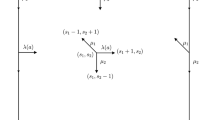Abstract
We consider a two-stage tandem queueing network where jobs from station 1 join station 2 with a certain probability. Each job incurs a linear holding cost, different for each station. Each station is attended by a dedicated server, and there is an additional server that is either constrained to serve in station 1 or can serve in both stations. Assuming no switching or other operating costs for the additional server, we seek an allocation strategy that minimizes expected holding costs. For a clearing system we show that the optimal policy is characterized by a switching curve for which we provide a lower bound on its slope. We also specify a subset of the state space where the optimal policy can be explicitly determined.
Similar content being viewed by others
References
Ahn HS, Duenyas I, Zhang R (1999) Optimal stochastic scheduling of a two-stage tandem queue with parallel servers. Adv Appl Probab 31:1095–1117
Ahn HS, Duenyas I, Lewis ME (2002) The optimal control of a two-stage tandem queueing system with flexible servers. Probab Eng Inf Sci 16:453–469
Ahn HS, Duenyas I, Zhang R (2004) Optimal control of a flexible server. Adv Appl Probab 36:139–170
Duenyas I, Gupta D, Olsen T (1998) Control of a single server tandem queueing system with setups. Oper Res 46:218–230
Farrar T (1993) Optimal use of an extra server in a two station tandem queueing network. IEEE Trans Autom Control 38:1296–1299
Gel ES, Hopp WJ, Van Oyen MP (2002) Factors affecting opportunity of worksharing as a dynamic line balancing mechanism. IIE Trans 34:847–863
Iravani S, Posner M, Buzacott J (1997) A two-stage tandem queue attended by a moving server with holding and switching costs. Queueing Syst 26:203–228
Javidi T, Song NO, Teneketzis D (2001) Expected makespan minimization of identical machines in two interconnected queues. Probab Eng Inf Sci 15:409–443
Pandelis DG, Teneketzis D (1994) Optimal multiserver stochastic scheduling of two interconnected priority queues. Adv Appl Probab 26:258–279
Rosberg Z, Varaiya P, Walrand J (1982) Optimal control of service in tandem queues. IEEE Trans Autom Control 27:600–609
Schiefermayr K, Weichbold J (2005) A complete solution for the optimal stochasting scheduling of a two-stage tandem queue with two flexible servers. J Appl Probab 42:778–796
Serfozo R (1978) An equivalence between continuous and discrete time Markov decision processes. Oper Res 27: 616–620
Van Oyen MP, Gel ES, Hopp WJ (2001) Performance opportunity for workforce agility in collaborative and noncollaborative work systems. IIE Trans 33:761–777
Weber RR, Stidham S (1987) Optimal control of service rates in networks of queues. Adv Appl Probab 19:202–218
Wu CH, Lewis ME, Veatch M (2006) Dynamic allocation of reconfigurable resources in a two-stage tandem queueing system with reliability considerations. IEEE Trans Autom Control 51:309–314
Author information
Authors and Affiliations
Corresponding author
Rights and permissions
About this article
Cite this article
Pandelis, D.G. Optimal use of excess capacity in two interconnected queues. Math Meth Oper Res 65, 179–192 (2007). https://doi.org/10.1007/s00186-006-0112-2
Received:
Accepted:
Published:
Issue Date:
DOI: https://doi.org/10.1007/s00186-006-0112-2




